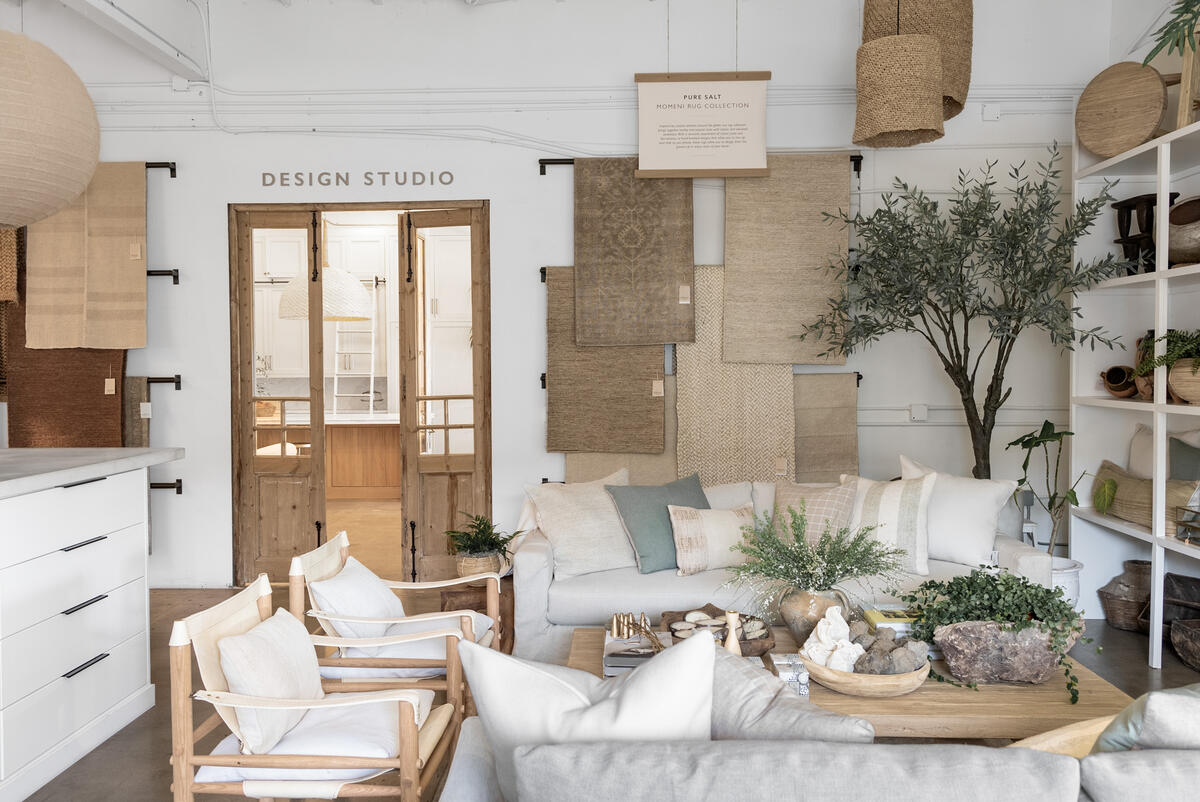In the fall of 2021, the pandemic-induced housing boom reached its peak. Home Business published a guide for designers who wanted to get into e-commerce. The article reflected the digital gold rush spirit of the time, right down to its upbeat title, “Everything you wanted to know about e-commerce (but were afraid to ask).” Everyone was buying furniture and decor, and doing it all online. Shouldn't designers get in on the action too?
Many did. Whether it was affiliate deals, dropshipping sites, tools like SideDoor, or simply putting pillows and candles in spare rooms, designers found some way to do business online. Those who were in the industry pre-COVID grew, and businesses that launched in the wake of the pandemic quickly gained momentum. For many designers, it was a welcome validation: After years of responding to Instagram direct messages about where to buy side tables, they could finally sell them themselves.
Three years later, the gold rush is over. E-commerce retailers like Bellacor, Burke Decor, and Food52 are struggling or closing their doors, while two of the industry's brightest stars, Justina Blakeney and Athena Calderone, recently announced they were closing their online stores to focus on other ventures. Everywhere you look, it seems designers are quietly removing Shop tabs from their websites.
It's fair to ask: Has e-commerce entered an era of failure?
Tough situation
It's an obvious one, but it's worth saying: No part of the home industry, online or offline, is doing particularly well right now. It seems like every week a century-old family-owned furniture store closes its doors or a long-established North Carolina manufacturer announces layoffs. And yet, e-commerce has its own struggles.
First, online shopping has been sluggish overall since the peak of the pandemic. From 2019 to 2021, purchasing activity increased sharply, rising from 10% to almost 17% of U.S. retail sales. Futurologists boldly predicted that the future of e-commerce was inevitable and that brick-and-mortar stores were dead. But since then, the share of online shopping has remained roughly flat and declined quarter after quarter. The situation has been particularly bad for household goods.

Justina BlakeneyDavid
“We were cautiously optimistic that in spring '24 we would start comparing sales to last year, and we figured that because 2023 was so sluggish compared to 2022, we would start hitting those numbers,” says Calla Murphy, senior vice president of digital strategy at Belardi Wong, a retail marketing agency with high-profile home business clients. “But that wasn't the case. … In April, home décor e-commerce was down 14% year over year. We looked at the numbers for May, and it was the same. [decrease]. “
Murphy said Berardi Wong's data shows that merchants that operate both e-commerce and brick-and-mortar stores are seeing their business shift to in-person shopping.Amid the overall digital downturn, there's another change: Large brands with annual sales of more than $25 million are doing much better online than smaller brands.
There's no single explanation for this. In part, it may just be that larger companies have more data, more customers, and are better able to make the most of bad market conditions. It's also nice to think that pivots by tech giants may be a factor. In the brick-and-mortar world, landlords may be tricky, but if you raise the rent, there are other stores. But there are no other stores like Google or Facebook. When one of the giant platforms makes a change or raises the prices of ad campaigns, smaller players can be hit harder.
Major changes over the past two years include Apple blocking ad trackers, skyrocketing advertising costs on Instagram and Facebook, Google’s recent price hikes, the adoption of multimedia Performance Max campaigns that allow low-cost brands to flood the market with fakes and cheap knock-offs – the list goes on.
“Marketing isn't getting cheaper, and things like Google's cost per click going up 10 percent are tough for smaller brands to stomach,” Murphy said. “Big brands have been able to pivot quickly and get more people seeing their ads. [platform shifts]…$10,000 in marketing dollars is not a lot of money for them. It’s rare for a new brand.” (It may be “unthinkable” for designers who run their sites on Shopify.)
Designers have also been hit especially hard by another tech giant's recent twist: As Instagram tweaked its platform to catch up with TikTok, emphasizing Reels and algorithmically recommended content, it inevitably shifted attention away from our industry. Whereas designers could once rely on Instagram as a surefire marketing channel, now there's no guarantee you'll reach even a fraction of their followers, making it harder to sell your services or side tables.
Many of these changes were happening during the pandemic, but while it was easy to set up an e-commerce store and make sales at the time because demand for home goods was overwhelming, the challenges in the ecosystem are now becoming more apparent as overall demand calms down.
Designers consider possibilities
These are dark times for companies that sell exclusively online. For independent designers who treat e-commerce like a side hustle, the situation is a bit different. Few designers are betting so big on e-commerce that a 10, 20, or even 60 percent drop in online sales would financially destroy their companies. As a result, the reaction to the upheaval is not outright panic, but a kind of soul-searching: In a softer market, is this worth doing?
Add in a post-pandemic desire to slow down, simplify and take a breather, and the answer may be no. “It started to become very active and it took a lot of machinery and people and energy to keep it going,” Blakeney told host Dennis Scully on a recent show. Home Business Podcast“I went from running an art and design company and spending most of my time and energy on creative stuff to suddenly spending a lot of time on marketing teams and A/B testing. … When that really became the core of my business, it started to wear me down.”
This rush is a big motivating factor. E-commerce may seem like a low-stress source of income—no rent to pay or salespeople to hire—but the reality is that selling products online can quickly become complicated and costly.
“Orders started pouring in when COVID hit, and we started hiring a lot faster and a lot more,” says Ali Morford of Pure Salt, a Newport, California-based company. Morford and partner Lee Lincoln had always wanted to incorporate a retail side into their business, and they started selling online well before the pandemic. But the housing boom meant they quickly upgraded their warehouse to 15,000 square feet for inventory and expanded their team from around 10 people to more than 35 to keep up with the influx of orders.

Pure Salt Interiors has both an e-commerce shop and a brick-and-mortar store, as you can see here.Courtesy: Pure Salt Interiors
Morford and Lincoln don't plan on abandoning e-commerce, but now that the COVID-19 pandemic is over, they're outsourcing the fulfillment portion of their online store to a third-party provider. “What we've come to terms with this year is that we need to simplify that side of the business. There are a lot of layers to it: operations, shipping, importing,” Morford says. “We want to continue with that, but we don't want it to take us away from our true purpose, which is design.”
Even drop-shipping sites, where designers don't hold inventory, can be complicated. Fairfax, Virginia-based designer Duval Reynolds launched her e-commerce site as an independent business in 2022. Though House of Duval runs entirely on a drop-shipping model, Reynolds said the process of launching and maintaining the site is time-consuming, including coordinating with vendors, writing copious amounts of copy and communicating with customers.
“When you actually play the game, you immediately realize a few things,” the designer says. “First, it's not free. There are many parts of it that cost money to play. [with the tech platforms]The other thing is that we need people who can run it full-time.”
The first illusion of e-commerce is that it's easy. The second is that it's risk-free. The hidden dangers of selling products online are familiar to designers: vendors don't always meet expectations, and customers end up angry. But on projects where the designer has influence over suppliers and a close relationship with the buyer, late or damaged goods can often be managed well. When selling to strangers over the open Internet, all that goes awry.
Vendors often have hundreds, even thousands, of customers to deal with and have more important issues to deal with. Customers can get angry and upset. One bad experience with the wrong shopper can expose a designer to a barrage of hateful social media comments and online reviews that can tarnish the company's reputation. Even if things don't get any worse, the reality is that quality control in e-commerce is fluid.
“For years, we have been exploring different mediums and ways to share our products outside of our design projects, but there were very few e-commerce platforms that could deliver exceptional results. [as you have] “It's becoming less controllable for consistent quality and experience,” says St. Louis designer Amy Studebaker, who experimented with online retail for years before recently exiting. “You do anything. Sometimes you just have to try things out and see what works. What works now may not work tomorrow. That's what makes it fun!”

Duval ReynoldsMarcus Wilborn
Long-term
Let's face it: we may be in the middle of a recession, but no one is predicting a permanent decline in online sales. Far from it. Last week, research giant Forrester released a forecast predicting steady growth in U.S. e-commerce over the next four years, reaching $1.6 trillion by 2028 and accounting for 28% of total retail sales (up from just under 16% today). Even if a surge in growth doesn't materialize, the general consensus is that online sales will increase, not decrease.
Moreover, the housing market will eventually recover, consumers will start spending on furniture and décor again, and the housing industry will emerge from the post-pandemic recession. Designers who persevere, stand out from the crowd, and find ways to reach consumers online will ultimately be the beneficiaries.
It's probably best to understand this period as a time of recalibration, not a setback. The days of “just doing it” e-commerce are coming to an end, and longtime industry enthusiasts are strategizing new approaches. Pure Salt's Morford and Lincoln have been looking for ways to double down on their strengths. “We're focused on doing bigger business with the vendors we partner with, which opens the door to creating unique products that other vendors and designers can't get, and that's been very successful for our brand,” Morford says. “Products that are available everywhere, meaning people can Google them all day long, it just makes the game harder.”
There's no denying that many designers are shying away from e-commerce, but the shift creates more opportunities for those who can find a niche to thrive in. Reynolds has been putting his digital store on the back burner in recent months, but some big recent sales have led him to speculate. “This could work for us,” he says, “if we jump on board.”


